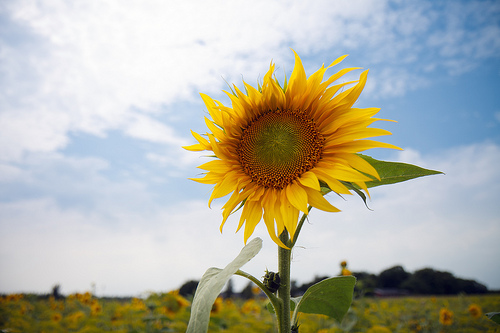You’ll need some shades if you visit a field of common sunflowers.
- Common sunflowers are a species of annual flower, popularly cultivated for agricultural purposes, and are native to parts of the North American countries of Mexico, the United States, and Canada.
- The scientific name of the common sunflower is Helianthus annuus and it is from the family Asteraceae, the family of daisies; and there are a large number of cultivars, these varying greatly in height and flower colour and size.
- Common sunflowers flowers generally have yellow petals, although orange and red tones are available, surrounding a brown central disc, and the flowers are usually a diameter of 10 to 50 centimetres (4 to 20 inches) and bloom during autumn and summer months.
- Contrary to popular belief, common sunflower flower heads do not continually change direction to face towards the sun, rather, they face east, though the flower buds do turn with the sun.
- Common sunflowers, also known simply as ‘sunflowers’, grow best in full sun, and they grow to heights between 0.5 to 5 metres (1.6 to 16.4 feet), depending on the variety.
Common Sunflower
Image courtesy of Stig Nygaard/Flickr
- Seeds and oil can be extracted from common sunflowers, which are edible by both humans and livestock, and the oil is often used in cooking and in margarine, cosmetics, soap and paint.
- Common sunflowers were introduced to Europe for food purposes in the 1500s by Spanish explorers, and this eventually spread to mass cultivation of the plants in Russia, Caucasus and Ukraine by the 1800s.
- The central disc of a common sunflower features a spiral pattern that can be mathematically defined using a formula that is part of the Fibonacci sequence.
- Common sunflowers are sometimes grown in domestic gardens for ornamental purposes; and they can be used to decontaminate soil and water from poisonous or otherwise harmful chemicals.
- Common sunflower petals have been used by native Americans to create a yellow dye, and the seeds to produce a black or blue dye.
Bibliography:
Helianthus annus, 2016, Wildflower Center, http://www.wildflower.org/plants/result.php?id_plant=HEAN3
Helianthus annus, 2016, Wikipedia, https://en.wikipedia.org/wiki/Helianthus_annuus
Helianthus annus, n.d, Missouri Botanical Garden, http://www.missouribotanicalgarden.org/PlantFinder/PlantFinderDetails.aspx?kempercode=a583
Helianthus annus (sunflower), n.d, Kew Royal Botanic Garden, http://www.kew.org/science-conservation/plants-fungi/helianthus-annuus-sunflower






